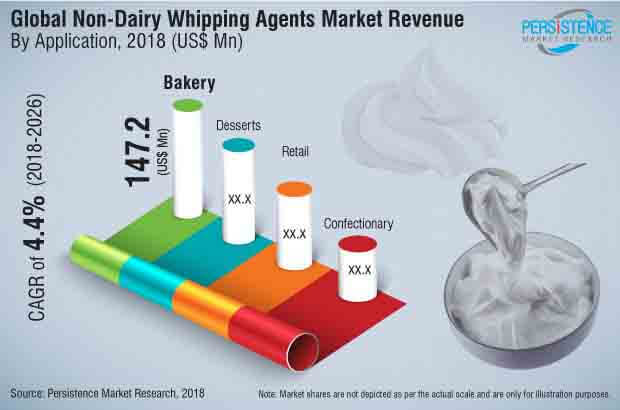Non-dairy Whipping Agents Market Segmented By Powder and Liquid Form in Confectionery, Dessert, Bakery
Industry: Food and Beverages
Published Date: December-2018
Format: PPT*, PDF, EXCEL
Delivery Timelines: Contact Sales
Number of Pages: 230
Report ID: PMRREP25918
Non-dairy whipping agents are liquid formulations or spray dried powders, which when mixed with water or milk, followed by whipping, form whipped cream with a desirable texture and taste. Used in multiple verticals of the food industry such as confectionary, bakery, desserts, etc., a non-dairy whipping agent is an ingredient of high importance in the food industry.
Non-dairy whipping agents are more often preferred over their dairy counterparts, owing to their cost feasibility. Non-dairy whipping agents are also highly modifiable, as they are not dependent on the dairy cream content in them for their function. Non-dairy whipping agents are also available that are derived from sources of preference, or can be tailor-made for a specific application such as for food processing or for decoration purposes.
In terms of volume, the liquid form of the non-dairy whipping agents market clearly leads the way. This is due to multiple factors such as ease of availability, ease of use and storage, and availability of non-dairy whipping agents through retail sales for a wider consumer base to reach. The powder form of non-dairy whipping agents is not highly utilized as of now, but is expected to reach a marginally higher CAGR than the liquid form of non-dairy whipping agents over the forecast period.
The bakery industry is expected to remain a large influence on the non-dairy whipping agents market, largely due to multiple applications of non-dairy whipping agents in bakery products. This influence of bakery products in the non-dairy whipping agents market can be attributed to Europe and North America, primarily, and secondly APAC. APAC presents itself with multiple opportunities for the growth of the non-dairy whipping agents market, since the region has multiple developing countries that have acquired a taste for Western food, and are home to a fast-moving bakery industry.

The increasing demand for non-dairy whipping agents from developing countries can be observed to stem from the dairy-free movement that is gaining traction in Western culture, where consumers are shifting from dairy-based products to dairy substitutes across all food types. Manufacturers have also jumped in on this opportunity, and have been offering multiple dairy-free whipping agent alternatives based on soybean proteins, sunflower proteins, and vegetable oils instead of milk fats to attain the much sought-after dairy-free label.
On the other hand, for developing regions, the cost feasible nature of non-dairy whipping agents is the appealing factor. For mass production of confectionary or processed bakery products, the cost feasibility of non-dairy whipping agents is the primary parameter for manufacturers. Even so, whipped cream manufacturers are introducing non-dairy counterparts of whipped cream products in developing regions as well; a major example of which is Rich Gravis introducing its non-dairy whipped cream in the Indian market recently to conform the requirements of the modern Indian consumers. Multiple other market players have also introduced coconut-based and palm oil-based non-dairy whipping agents into the market.
Restraints for the non-dairy whipping agents market are present in particular types of non-dairy whipping agents, such as the one derived from palm oil. Worldwide, excessive deforestation due to increasing palm oil demand is leading to an environmental crisis, which is not sustainable in the long run. This can raise environmental concerns and can present itself as a probable restraint for the non-dairy whipping agents market.
In terms of value, the global non-dairy whipping agents market is expected to exhibit an incremental opportunity of US$ 593.7 Mn by 2026 end over 2017. By form, the powder segment is anticipated to register a healthy CAGR of 4.1 % in the non-dairy whipping agent market.
The European region, while being the largest consumer for non-dairy whipping agents, is also expected to experience slow growth over the forecast period. This slow growth in the demand for non-dairy whipping agents is evidently due to an already matured market. APAC and Latin America hold higher promise for growth in the non-dairy whipping agents market, owing to the presence of a thriving bakery industry and multiple rapidly developing countries
The report analyses the market share of the non-dairy whipping agents on the basis of application, end use, form, and region. A section of the report highlights the region-wise demand for non-dairy whipping agents. It provides a market outlook for 2018-2026, and sets the forecast within the context of the non-dairy whipping agent’s ecosystem, including new technological developments as well as product offerings in the global non-dairy whipping agents market.
This study discusses the key regional trends contributing to the growth of the non-dairy whipping agents market, globally, as well as analyses the degree at which the drivers are influencing the non-dairy whipping agents market, globally. Key regions assessed in this report include North America, Latin America, Europe, APAC, and the Middle East & Africa.
To know more about delivery timeline for this report Contact Sales
